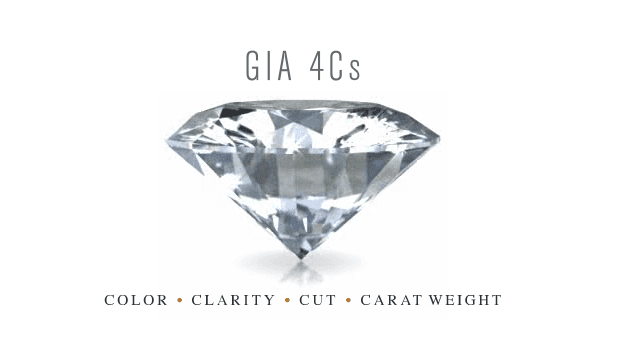

Choosing A Diamond: Understanding The 4Cs

Choosing A Diamond –
If you’re reading this, chances are that Congratulations are in order! Compared to choice of your life partner, choosing a diamond is simple. Common shopping questions include “How do I know it’s real?” “Is the diamond treated?” And “How much should I spend?”
Understanding the Four-C’s – attributes affecting a diamond’s beauty and value – is key, in making an informed diamond choice. The Four-C’s of diamond grading, in a nutshell, are Color, Clarity, Cut and Carat weight. Some of the four C’s are most important than others. Knowing this simplifies the decision-making process. Then one can move on to more important issues, such as popping the question! The Four-C’s comprise the internationally recognized GIA’s (Gemological Institute of America’s) diamond-grading system.
Color
The less color, the higher the grade. The higher the grade, the rarer and more expensive a diamond will be. Diamond color is graded from D to Z in the international GIA Diamond grading System. Near-colorless diamonds are raindrop white to the eye in a platinum or white gold setting. They range in color from G to J. Because near-colorless diamonds are not as rare as the highest color grades (D to F), their price is lower, all other attributes being equal.
Clarity
Virtually all diamonds have natural internal characteristics, or identifying marks, known as inclusions. Diamonds’ clarity grades are determined under 10 times magnification. GIA Clarity grades range from Flawless to I3, with nine grades in between. Under magnification greater than 10-power, even a Flawless diamond might reveal miniscule inclusions.
Because so many diamonds’ inclusions are visible only with magnification, they do not affect most diamonds’ beauty. For that reason, clarity has less overall impact on a diamond’s beauty than the other three C’s. The clearer a diamond, the rarer it is. The higher the grade, the rarer and more expensive a diamond will be.
Only the lowest three clarity grades (I1 to I3), when correctly graded, contain inclusions that are visible and/or prominent without magnification. Inclusions in diamonds having these lowest clarity grades might understandably be referred to as flaws.
Cut
Nature determines the other three C’s. Cut is the only Four-C attribute where humans play a part. A diamond’s cut determines its ability to sparkle and has the highest impact on a diamond’s beauty. For that reason, we consider Cut the most important attribute among the Four-C’s. It should also be part of your consideration when choosing a diamond.
Diamond cutters craft the rough diamond crystal into a polished gem. Ideally, cutters are mindful of the angles and proportions that will maximize sparkle. When beam of light enters an ideally cut diamond, it is reflected in sparkle and a dispersed in a play of rainbow colors through the diamond’s top.
When a diamond’s cut is too shallow, light leaks out through its bottom. When cut too thickly or deep, light escapes through the diamond’s sides.
Cut also is a term used to describe a diamond’s shape or outline, such as round, oval, square, triangular, pear-shaped, etc.
Carat Weight
Is exactly that – how much the diamond weighs. Weight is indicated in carats and points. One carat equals 1/5 gram, or 200 mg. There are 100 points in a carat, similar to pennies to a dollar. Thus a 25 point diamond weighs 25/100, 0.25 or ¼ carat.
Because of variations in cutting, carat weight is not necessarily an accurate representation of a diamond’s size appearance. A diamond’s size is best understood through a combination of factors: the diamonds weight, its cutting grade, and measurements across its top – the face-up position – measured in millimeters. The larger a diamond the rarer it is, other factors being equal.
We’d be proud to show you some of the diamonds we’ve personally selected. Contact us by phone or email or visit our showroom nestled in the heart of the Freeport, Maine outlets.


